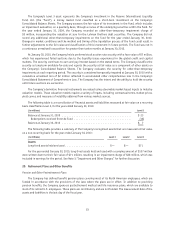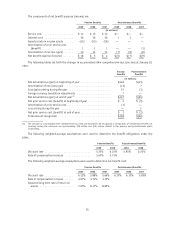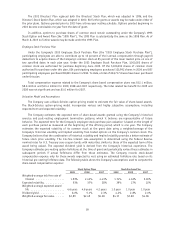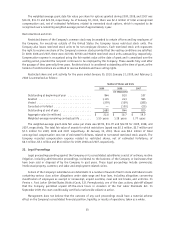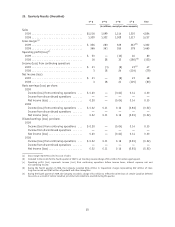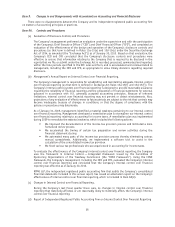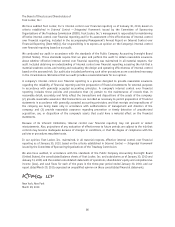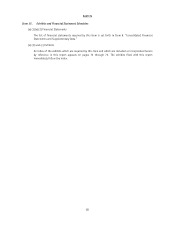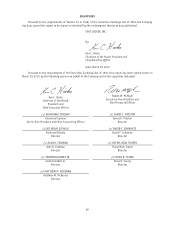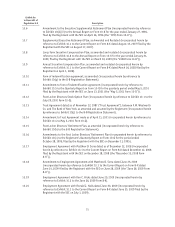Foot Locker 2009 Annual Report Download - page 79
Download and view the complete annual report
Please find page 79 of the 2009 Foot Locker annual report below. You can navigate through the pages in the report by either clicking on the pages listed below, or by using the keyword search tool below to find specific information within the annual report.
The weighted-average grant date fair value per share for options granted during 2009, 2008, and 2007 was
$10.02, $11.73 and $22.38, respectively. As of January 30, 2010, there was $2.0 million of total unrecognized
compensation cost, net of estimated forfeitures, related to nonvested stock options, which is expected to be
recognized over a remaining weighted-average period of approximately 1 year.
Restricted Stock and Units
Restricted shares of the Company’s common stock may be awarded to certain officers and key employees of
the Company. For executives outside of the United States the Company issues restricted stock units. The
Company also issues restricted stock units to its non-employee directors. Each restricted stock unit represents
the right to receive one share of the Company’s common stock provided that the vesting conditions are satisfied.
In 2009, 2008 and 2007, there were 227,000, 87,500 and 90,000 restricted stock units outstanding, respectively.
Compensation expense is recognized using the fair market value at the date of grant and is amortized over the
vesting period, provided the recipient continues to be employed by the Company. These awards fully vest after
the passage of time, generally three years. Restricted stock is considered outstanding at the time of grant, as the
holders of restricted stock are entitled to receive dividends and have voting rights.
Restricted share and unit activity for the years ended January 30, 2010, January 31, 2009, and February 2,
2008 is summarized as follows:
Number of Shares and Units
2009 2008 2007
(in thousands)
Outstanding at beginning of year .............. 844 810 537
Granted ............................... 1,115 243 583
Vested ................................ (279) (109) (285)
Cancelled or forfeited ...................... — (100) (25)
Outstanding at end of year ................... 1,680 844 810
Aggregate value (in millions) ................. $ 22.6 $ 16.7 $ 19.0
Weighted-average remaining contractual life ....... 1.50 years 1.28 years 1.77 years
The weighted-average grant-date fair value per share was $9.90, $11.79 and $22.95 for 2009, 2008, and
2007, respectively. The total fair value of awards for which restrictions lapsed was $5.2 million, $2.7 million and
$7.3 million for 2009, 2008 and 2007 respectively. At January 30, 2010, there was $8.0 million of total
unrecognized compensation cost net of estimated forfeitures, related to nonvested restricted stock awards. The
Company recorded compensation expense related to restricted shares, net of estimated forfeitures, of
$8.3 million, $5.1 million and $5.6 million for 2009, 2008 and 2007, respectively.
22. Legal Proceedings
Legal proceedings pending against the Company or its consolidated subsidiaries consist of ordinary, routine
litigation, including administrative proceedings, incidental to the business of the Company or businesses that
have been sold or disposed of by the Company in past years. These legal proceedings include commercial,
intellectual property, customer, and labor-and-employment-related claims.
Certain of the Company’s subsidiaries are defendants in a number of lawsuits filed in state and federal courts
containing various class action allegations under state wage and hour laws, including allegations concerning
classification of employees as exempt or nonexempt, unpaid overtime, meal and rest breaks, and uniforms. In
Pereira v. Foot Locker (United States District Court, E.D. Pennsylvania), one of the class actions, plaintiff alleged
that the Company permitted unpaid off-the-clock hours in violation of the Fair Labor Standards Act. In
September 2009, the court conditionally certified a nationwide collective action.
Management does not believe that the outcome of any such proceedings would have a material adverse
effect on the Company’s consolidated financial position, liquidity, or results of operations, taken as a whole.
61




